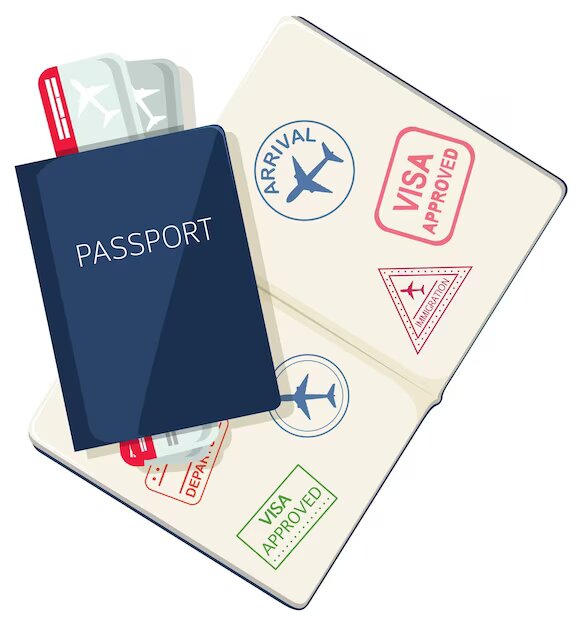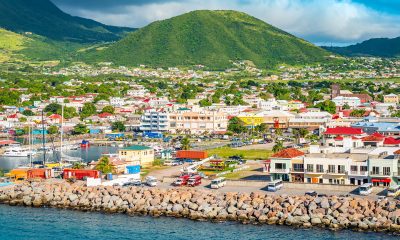Travel
Ultimate Guide To Understanding The Types Of Visas

Most tourists, whether for business or pleasure, need a visa. Visas should not prevent you from traveling, even though they can be difficult to obtain. We’ll explain visas and their varieties so you may travel confidently.
Visas are crucial for international travel. What’s visa? Visas allow foreigners to travel abroad. By specifying the trip’s goal, duration, and conditions, they assure safe and seamless travel. Vacations with visas allow you to follow the host country’s laws.
This article discusses the importance of travel visas and their function in international travel, including how many sorts there are and what they look like. We’ll focus on visa kinds by purpose (tourism, business, work), duration (short-term, long-term), and eligibility. We wish to clarify international travel restrictions and help you plan your next international trip by studying visa types.
Types of visa based on validity period
Some visas are categorized by validity. Visa validity is the time a visa is valid and allows the holder to enter and stay in the country. Validity period differs from stay, which is the length of time a person can stay in the country following arrival. Simply put, a two-year visa may only enable six-month stays. The stay is shorter than the validity. You can travel whenever your visa is valid as long as you don’t overstay.
Visas are classified by validity as short-term, long-stay, or permanent residency. Lets get into it:
1. Short-stay Visas
Short-stay visas are often only valid for a few days or several months. They are intended for tourism, business trips, and short-term stays. You may be required to show evidence of accommodation, a return ticket, and financial documents.
2. Long-Stay Visas
Long-stay visas are good for several months to a few years. They are intended for purposes such as work, study, or family reunification. This visa category may require paperwork particular to the purpose, such as a job offer for work visas or acceptance into an educational institution for student visas.
3. Permanent Residency Visas
Permanent residency permits provide permanent residence in the host country. They’re usually given for work, family, or investment. These require a qualifying duration of temporary residency, language proficiency, and proof of integration into the host society and are harder to obtain.
Understanding the differences between these visa categories can help you choose one. Permanent residency visas are a good choice for relocating, but they require more planning. Short-term visas are good for vacations, whereas long-term visas are good for study abroad or long-term work. Whatever your trip demands, choose the right visa and don’t overstay in the host country.
Types of visa based on number of entries
Visas can also be differentiated based on the number of entries allowed. Single-, double-, and multiple-entry visas are the main types. These categories influence how often a visa holder can enter the host country. Selecting the right number of visa entries can affect your travel freedom. Most holidays only require a single-entry visa, however you may want a multiple-entry visa to visit nearby countries. Details of the categories:
1. Single-Entry Visas
Single-entry visas allow for one entry into the host country throughout the visa’s validity period. When the visa bearer leaves the host country, the visa becomes invalid. These are often given for short-term visits, such as tourism or attending a special event, where just one entry is required.
2. Double-Entry Visas
Double-entry visas allow the visa holder to enter the host country twice within its validity period. They are more flexible because, after the first entry, the visa is valid for a second. Business travelers or tourists who want to visit surrounding countries during the same trip and need to re-enter the host country will often apply for this sort of visa.
3. Multiple-Entry Visas
Multiple-entry visas allow the visa holder to enter the host country many times throughout the visa’s valid period. This visa category provides the most flexibility, allowing for several entries without having to seek for a new visa. These visas are typically requested by business professionals, frequent visitors, or persons with long-term commitments in the host country.
What are some examples of where these types of visas might be used?
The amount of visa entries determines your travel mobility. A single entry visa is usually enough for a brief vacation in a foreign nation. You’ll enter the country, see the sights, then leave.
However, a business traveler who wants to attend meetings in one host country and then visit a nearby country for more business operations before returning home needs a different visa. A double-entry visa may work here.
Finally, if you are a foreigner working international who frequently returns home for personal reasons or a business professional with continuing projects that require many visits to the host country, a multiple-entry visa may be best. Planning your vacation and complying with immigration laws requires understanding single-, double-, and multiple-entry visas. Your entry type should match your travel demands and projected destination visits.
Types of visa based on the process of application
There are many ways for obtaining a visa, some manual and some digital, depending on the format. The most prevalent ways to obtain visas are sticker visas, e-visas, and visas on arrival. Each has a unique application process, as well as distinct benefits and drawbacks. This section will go over the many types of visas and the application process for each.
Sticker Visas
Sticker visas are the most traditional kind and typically involve applying for a visa at a consulate or embassy, where a physical visa (sticker) is affixed to your passport.
- Advantages: Provides a tangible document for entry, allowing travelers to plan and receive approval before departure.
- Disadvantages: May require in-person visits to embassies or consulates, which can be time-consuming. Processing times may vary.
E-Visas
E-visas can be processed totally online. Most countries will give travelers with an official, secure electronic platform to complete their applications. E-visas are frequently provided directly to your email, with the granted visa digitally connected to your passport.
- Advantages: Convenient and time-efficient, eliminating the need for physical visits. Processing times are often quicker, and applicants can track their status online.
- Disadvantages: Technical issues or internet connectivity problems may hinder the application process. Some countries may have limited eligibility for e-visas.
Some eligible travelers can obtain visas upon arrival at the port of entry (airport or land border). This sort of visa is usually granted to tourists whose home country has good relations with the country they are visiting. If you know you are eligible for a visa on arrival, make sure you have enough money to cover any potential fees while traveling.
- Advantages: Immediate approval upon arrival, convenient for last-minute or spontaneous travel plans. No need for pre-application.
- Disadvantages: Limited to certain nationalities, and visa fees are usually paid upon arrival. Processing times may vary, leading to potential delays.
Where would these types of visa typically appear?
Your nationality and travel destination will determine your visa application and format. Many travelers need sticker visas for the US, China, and India. Depending on the visa category, sticker visas require application paperwork, passport pictures, and supporting documentation. Spanning many EU nations with a single visa, the Schengen visa simplifies travel for tourists and business travelers.
Australian, Turkish, and Kenyan e-visas are practical alternatives to sticker visas. This visa type usually requires a valid passport, a digital passport photo, and visit details.
Thailand, Indonesia, and Egypt provide visa-on-arrival for certain travelers. Travelers seeking visas on arrival usually need a passport, return ticket, and evidence of lodging. Make sure you’re from an approved country before using this option.
Understanding the advantages and cons of each visa application process can help you choose the best one for your nationality, location, travel plans, and preferences. Also, research country requirements to guarantee a smooth application and entry into your target destination.
Visa types based on the purpose of travel
We can also consider visa classification by travel purpose. Most countries offer purpose-based visas for specific purposes. When traveling abroad, one may wonder, “what are the 4 types of visa?” Tourist, business, student, and work visas are typically issued for short-term visits, professional engagements, and global employment. Each type is tailored to visitors’ needs to comply with destination country laws. However, there are additional visas for different travel objectives and criteria, giving international travelers more options.
Here are some of those categories explained in more detail:
- Tourist visas are designed for individuals seeking leisure travel, allowing them to explore a foreign country for a specific duration.
- Business visas facilitate travel for professional purposes, such as meetings, conferences, or negotiations.
- Student visas enable individuals to pursue education abroad, permitting them to enroll in academic institutions.
- Work visas are tailored for those seeking employment opportunities in a foreign country, covering various professions and industries.
- Family visas are granted for reunification purposes, allowing family members to join or remain with their loved ones.
- Investor visas are often linked to financial commitments, encouraging individuals to invest in the host country’s economy.
- Transit visas cater to individuals passing through a country en route to their final destination, with a limited stay during the transit period.
Note that each visa category has different requirements, so pay attention to them. Tourist visas may require lodging and a return ticket. Business visas may require a host firm invitation letter, while student visas require academic approval and financial support. A work visa may require a job offer, while a family visa may require proof of relationship and financial stability. Transit visas may need documents of onward travel, and investor visas require a large investment. Each visa category has varied rules and criteria based on its function. Knowing the differences between purpose-based visa categories will make your foreign trip easier and more secure.
Discover the globe: the magic of tourist visas
The most frequent visas are tourist visas, which allow you to travel freely and securely. Vacationers, sightseekers, and cultural explorers will love these visas. Tourist visas usually have a limited stay of a few days to many months, depending on the destination. They rarely let holders work or study.
Tourist visa applications usually require a valid passport, a visa application form, passport-sized photos, and proof of financial assistance. A complete travel schedule, hotel verification, and a return ticket may be required in some countries. Tourist visas can be applied for at the host country’s embassy or consulate or online via an e-visa system. Before applying, double-check these data as they differ by country.
Tourist visas are required for many famous tourist locations. Most Schengen Zone, North American, and other nations require tourists to have visas before entering. Some countries have simplified e-visa processing. Understanding the visa criteria of the vacation location will streamline the application process and ensure success.
Visa-free and visa-on-arrival countries
Visa-free travel and visa-on-arrival allow foreigners to enter a country without a visa. Visa-free travel allows citizens of qualified countries to enter another country for a certain time. Foreign diplomatic agreements or reciprocal arrangements often grant this privilege. Visa-on-arrival simplifies pre-travel visa application by allowing visitors to get a visa at their destination’s port of entry.
These processes are convenient, however country conditions may differ and alter. Visa-free or visa-on-arrival travel expands travel options for eligible people. If you are not qualified for these choices, failing to meet international visa criteria may result in denial, delays, or legal action. Therefore, you should carefully examine each destination’s visa policies, taking into account nationality, expected stay length, and visit purpose.
Staying knowledgeable about visa restrictions helps travelers make informed decisions, avoid surprises, and travel smoothly. Online resources, embassy websites, and travel agents can provide current visa requirements to assist you plan for international travel. Before traveling, check visa requirements to avoid problems.
Basically
This article discussed many important visa categories and their subcategories. Visas were examined by purpose, entrance, and duration. Tourist, business, student, work, family, investor, and transit visas are purpose-based. Single-, double-, and multiple-entry visas exist. Short-term, long-stay, and permanent resident visas exist. We examined sticker, e-visa, and visa-on-arrival visas based on application methods. We defined visa-free travel and who qualifies.
Proper visa selection guarantees that your vacation plans comply with international travel requirements. Consult visa alternatives based on your trip’s purpose and destination. A thorough visa selection and application process will improve your chances of a smooth and enjoyable international trip.












